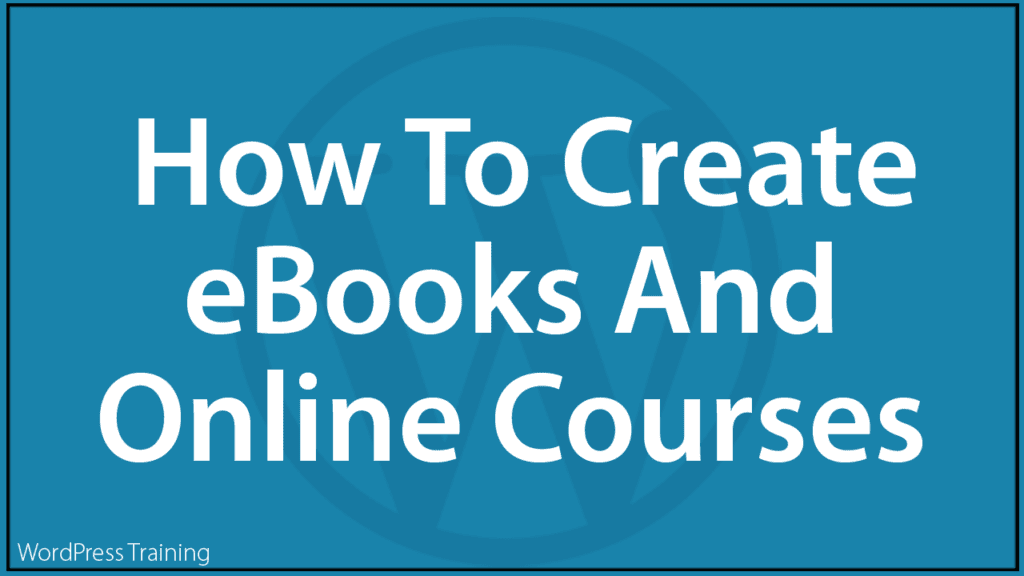How To Self-Publish eBooks And Create Online Courses

This tutorial is part of our series on using content marketing to create more exposure online for your business and drive more traffic to your site.
Subscribe to our web content creation course and learn how to never run out of great content for your website, blog, or newsletter.
***
For additional information, see this tutorial: Content Marketing With eBooks
***
If you are looking for effective ways to promote and grow your business, attract new clients, or create additional revenue streams, then consider publishing an ebook or creating an online course.
Having a book (or e-book) or an online course can help you:
- Increase awareness about your business, products, or services and reach new target audiences.
- Educate prospects about your business and train/empower existing customers or clients.
- Drive more leads and prospects to your website.
- Gain a competitive business advantage.
- Build credibility, authority, trust, and expertise in your niche or industry.
In this tutorial, we’ll show you how to publish books and create online courses as part of your content marketing strategy.
Turn Specialized Knowledge Into an eBook or eCourse
The currency of the ‘Digital Information Age’ is content. Becoming a content publisher allows you to participate in the digital economy as a creator and not just a consumer.
We not only live in the digital age, we also live in the age of specialization.
Specialization: The process of concentrating on and becoming expert in a particular subject or skill.
Source: Oxford Dictionary
Regardless of what business you are in, you most likely have specialized or expert knowledge, experience, and access to information about subjects that can add value and benefit others.
This information can be developed into a book (or e-book) and/or an online course.
In addition to the benefits already mentioned, publishing books and e-courses can also help you organize your thinking and gain greater clarity and understanding about your business and your business processes.
Additionally, with a little planning, you can create a book or course over time by publishing the content as blog posts or emails (e.g. newsletters) initially while building the content and chapters of your book or course modules. After a while, you will have built enough content to compile and collate your blog posts or newsletters to form your ebook or e-course.
Authoring Vs Publishing Content
This tutorial is about ‘publishing’ content. Many people are put off by the idea of authoring and creating a book that can help them market and promote their business because they think they need to become skilled writers.
There is a difference between authoring and publishing a book.
J. K. Rowling authored the Harry Potter series, but Bloomsbury published it.
You don’t need to create all of the content yourself, however, in order to publish it.
Of course, if you have knowledge and expertise about a subject you can write the book yourself and there are many benefits in doing this, but you don’t have to be a writer to create a book.
For example, you can:
- Hire writers and editors to ghostwrite and edit your book,
- Create a book with user-generated content (e.g. a collection of interviews or submissions from members of your target audience or social media groups).
![]()
Here are some recommended tools to help you create your ebook:
- Word Processor – Most ebooks, reports, guides, etc. are created and delivered in PDF format. Word processing tools like MS Word, Open Office, Google Docs, LibreOffice, etc. will let you easily save your book as a PDF file.
- Slide Presentations – Use a slide presentation tool to create charts, diagrams, flowcharts, illustrations, etc. A tool like MS Powerpoint lets you export slides as a .png or .jpg image.
- Image Editing – Use a screen capture tool (e.g. SnagIt) to create screenshots and Photoshop or GIMP to edit and save image files.
Additionally:
- For free and royalty-free stock photos and images, see this tutorial: Where To Find Free And Royalty-Free Images
- To learn about creating eBook covers for your books, see this tutorial: Content Marketing With WordPress – eBooks
For this tutorial, we’ll assume that you have already researched your ebook or course topic, written or outsourced the content writing, and you are now ready to self-publish it as an ebook or online course.
The ‘shoestring’ method described below will help you do this at a minimal cost.
Self Publishing eBooks On A Shoestring Budget
What’s the purpose of your book?
Are you publishing to make money selling copies of the book itself, or are you planning to use the book to increase exposure and create awareness for your business…or a combination of both (i.e. make money selling the book and attract new customers for your products or services)?
Your answer will determine strategic decisions, such as how and where you should publish your book, how much you should charge for it (or even give it away), etc.
If you’re publishing to make money and to promote your business, we recommend starting by self-publishing your content as an electronic book (e-book) before you consider other publishing methods and formats (e.g. printing hard copies via print-on-demand or traditional printing, contacting publishing companies, etc.).
Some of the reasons for starting with self-publishing include:
- Cost – Self-publishing is inexpensive compared to traditional publishing.
- Speed To Market – As you will soon see, you can literally turn your content or manuscript into a self-published ebook in minutes instead of weeks or months.
- Testing – Self-publishing allows you to test your product in the market and assess your results before investing more time, effort, and money into the process.
- Improvement – With an ebook, you can edit, refine, and improve your content if necessary, until you are happy with the results and ready to commit your book to print or invest in professional services (e.g. editors, distribution, publishers, etc.).
Let’s walk through the self-publishing process using the example e-book below.

For this tutorial, we’ll upload and publish our ebook to the Kindle Direct Publishing (KDP) program.
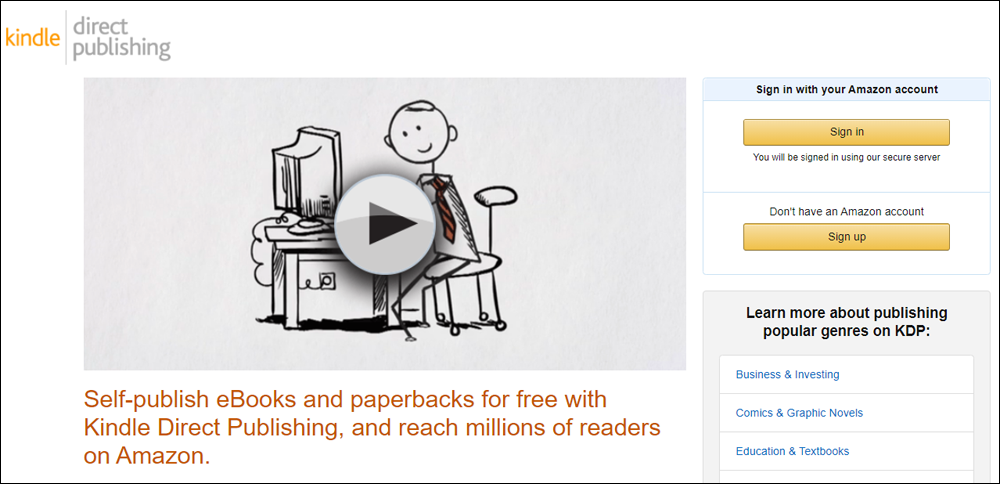
Here are just some of the reasons to publish the book on Amazon KDP:
- It’s FREE!
- It puts your book in front of a huge global audience.
- Books published on Amazon KDP can be read by all devices.
- The KDP lending library pays additional royalties for books that become popular and widely read/shared.
- KDP has promotional features that help you create more exposure for your book.
- You have control of your book and can edit the content and pricing as many times as you like after publication.
To set up a free account on the Amazon Kindle platform, go here: https://kdp.amazon.com
Formatting Your Book For Amazon KDP
You can create and upload your book to Amazon KDP using Microsoft Word or any of its supported formats.
To prevent formatting issues in your finished ebook, make sure to check out Kindle’s guide to content quality in the Amazon KDP help section and proof your content using the Online Previewer tool when uploading your file.
After formatting your document correctly, save your file somewhere that will be easy to locate when it’s time to upload.
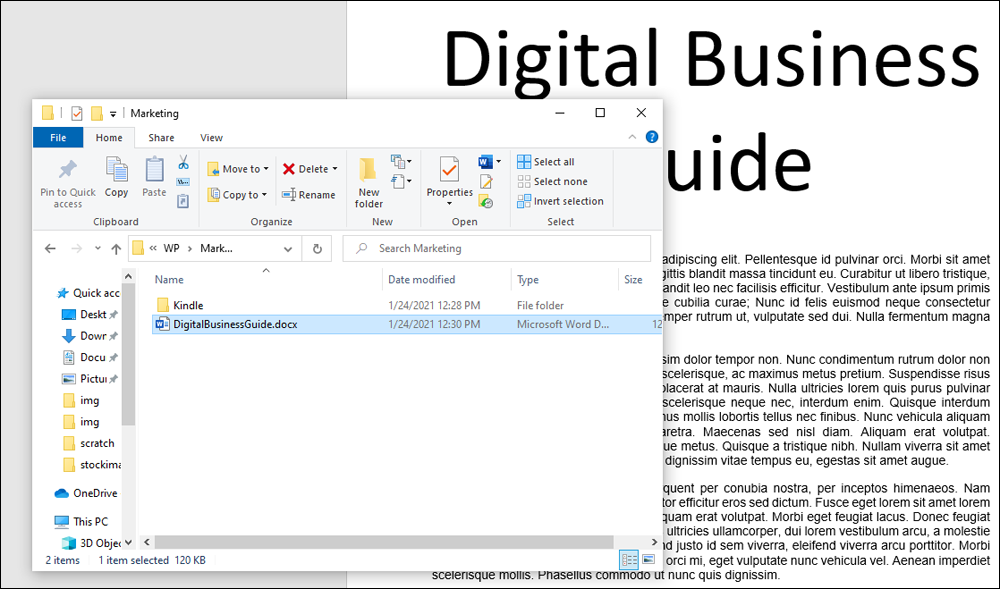
Before publishing to the KDP platform, you will also need to create a flat book cover image. This image needs to be quite large (for image specifications, go here).
You can create the book cover image yourself using Photoshop, outsource the work to a freelance graphic designer, or use Amazon’s own book cover creator tool during the upload process.
Just make sure you follow Amazon’s ebook cover image specifications if outsourcing the creation of your cover image. These specs are detailed in their help section.

Amazon KDP offers loads of free tutorials on their site everything from getting started, to formatting your content, promoting your book, etc.
We recommend going through these tutorials, especially the ones about formatting your book correctly and complying with KDP guidelines.
![]()
If you are asked to create or upload your ebook using a different file format (e.g. EPUB), you may need to save your file as a filtered web page.
If using Word, select Web Page, Filtered option from the Save As dropdown menu. This saves your document as a web page in a reflowable format that preserves its content and formatting, strips out unnecessary HTML code, and keeps the file size small.

If your book contains embedded media (e.g. images), this option will create two files: 1) your document saved as a web page and 2) a file containing all the elements to be included in your book content.

Zip the folder containing these two files and upload your zipped file.

Once you have everything ready, it’s time to upload your book.
Uploading Your Book To Amazon KDP
Uploading your book to Amazon’s KDP platform is a simple process.
After you have created your book files and registered your free account with KDP, go to https://kdp.amazon.com and click on ‘Sign in’…
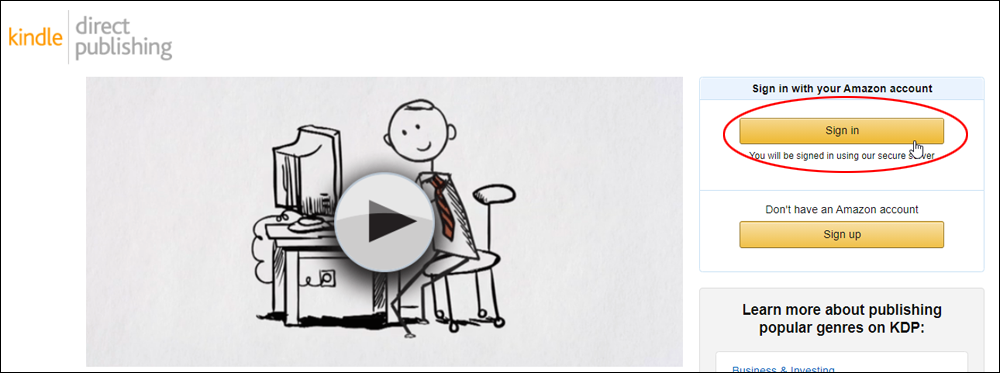
Next, log into your account…

This will bring you to your KDP dashboard, where you can view your books (Bookshelf), earning reports, participate in the active Kindle author community, and more.
If you haven’t published before, go to ‘Bookshelf’ and click on Create a New Title > Kindle eBook.
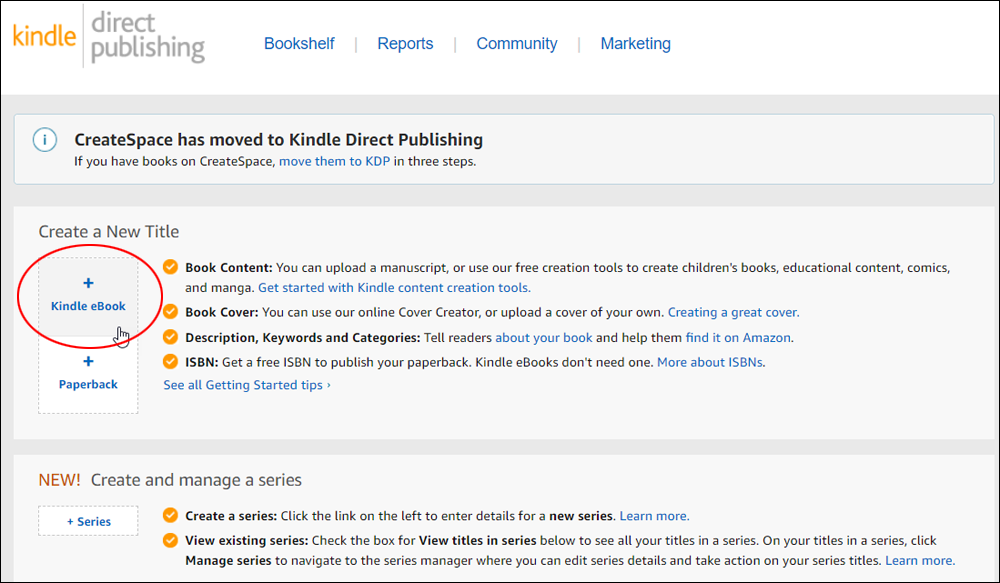
Now, simply go through each of the sections described below and fill in the details (refer to the KDP tutorials and user forum if you need help).

eBook Details
Add your book title and description, author name, keywords, and categories. Complete the other settings in this section (e.g. language, publishing rights, etc.), then click save to continue.
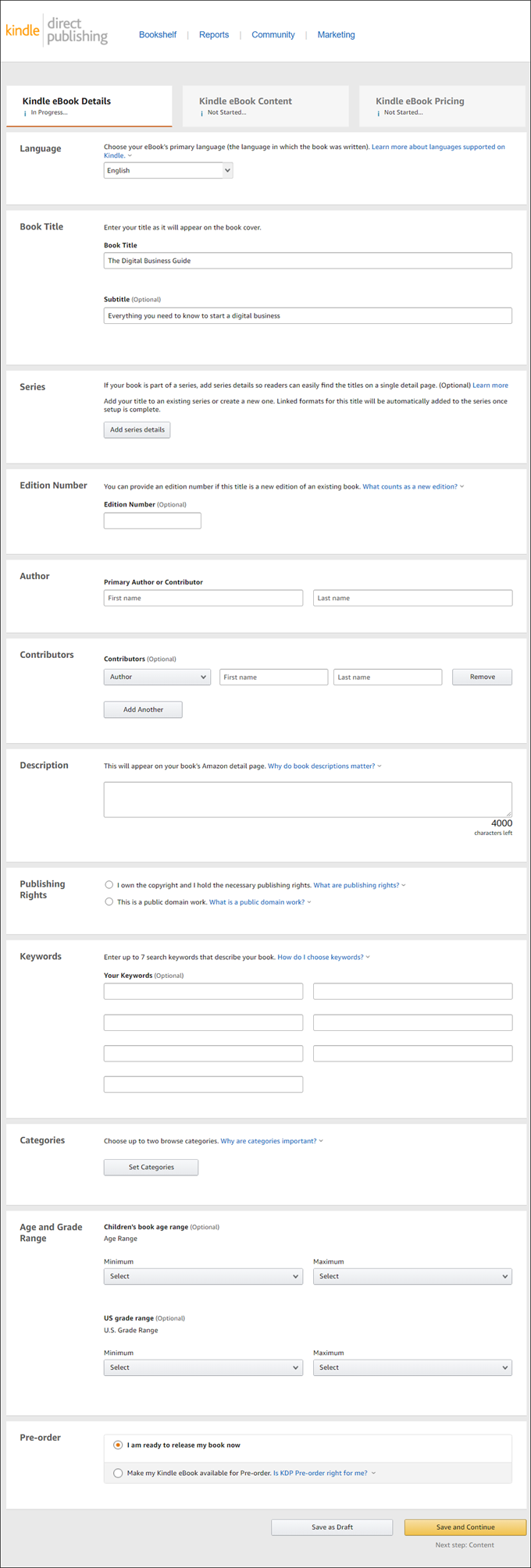
eBook Content
Next, upload your manuscript and book cover image.
As mentioned earlier, you can upload your own image, or use Amazon’s Cover Creator tool.

The KDP Cover Creator tool guides you through the process of choosing a cover design and lets you customize its layout, change elements, colors, and typefaces, and preview your book cover before you publish.

After uploading your book file and cover image, select your Digital Rights Management (DRM) settings and enter your ISBN if applicable, then preview your book and click ‘Save and Continue’.

eBook Pricing
In the last screen, specify your book’s distribution settings (e.g. worldwide or individual territories), pricing details, book lending options, etc.
Click the button when done to save it as a draft or publish your book.
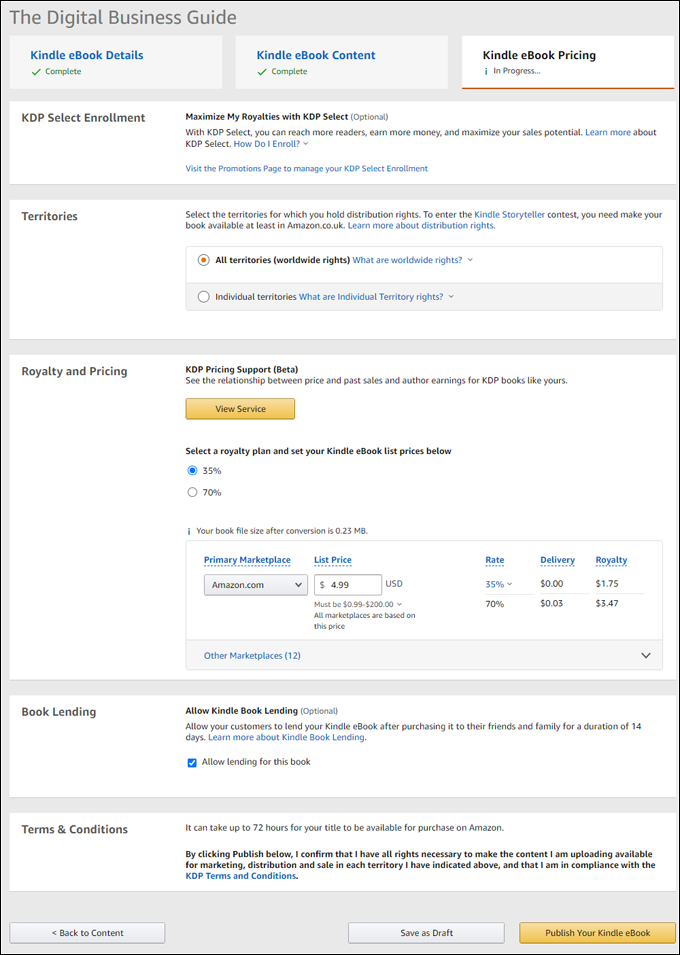
It normally takes a day or two for books to be reviewed, approved, and published.
Once your book is published, it will become live on the Amazon Kindle Book store and available for immediate purchase.

You can return to your account any time and edit your book details, upload a revised copy, change the pricing, etc.
![]()
Amazon Kindle Direct Publishing offers an option to help promote your book called KDP Select. When you enroll in the KDP Select program, your eBook is locked for 90 days. During this time, you are given 5 promotional days where you can give your ebook away on Amazon for free. After your 5 free days are used up, your eBook goes back to being sold for the amount you have specified.
You can renew this option. During each 90-day period, your eBook remains available in the Kindle Owners’ Library. While you are opted into the KDP Select program, you are not allowed to publish your book on other platforms, including publishing or giving the book away on your own website.
If your website isn’t pulling in enough traffic, we recommend starting off with a platform like Amazon KDP before looking at the option of selling and promoting your books on your website.
Self-Publishing Print On Demand (POD) Books
If you want to commit your book to printed format, Amazon offers you a ‘print on demand’ self-publishing option through a program called CreateSpace.
You can create and manage POD books inside your KDP account. Just make sure you read the guidelines for creating a paperback version of your book. This will help you avoid costly mistakes and result in a higher quality book.
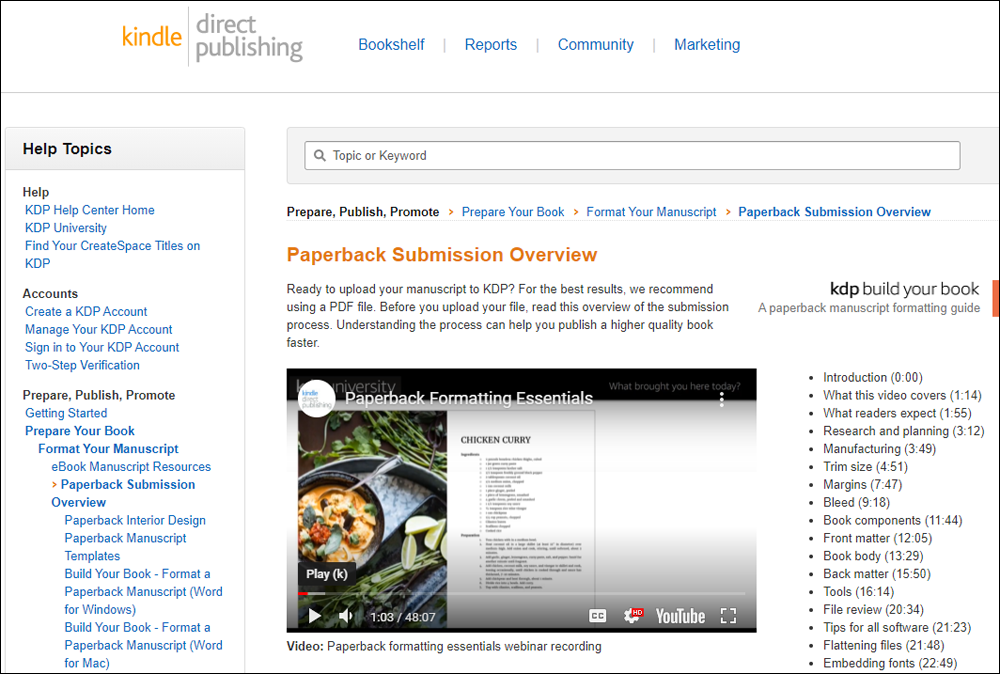
Before we move to the topic of discussing ways to promote your ebook, let’s take a look at the process of turning your book into an online course.
Turning Your Book Into An eCourse
After publishing your book, you may want to consider turning your book into an e-course. Here are just some of the many reasons to consider turning your book into an online course:
- Most of your course content is already written. An online course can be a natural extension of the work you’ve already done and the time you’ve already spent writing content for your book or business. In many cases, all you need to do is organize the information you already have into a format that will benefit others.
- Educate, train, and empower prospective customers. An online course can help train people to engage better with your business and empower them to become educated customers of your services. For example, if you run a craft supplies business, you could create an online course that shows people how to make unique craft objects or even how to start a business selling crafts made with items you supply.
- Expand your reach, leverage your expertise and increase revenue. Depending on your business, you may only be able to serve clients on a local level. An online course allows you to expand your reach on a global level and create additional revenue opportunities for your business.
- Leverage your marketing efforts. Just as publishing a book can help to establish authority, credibility, and expertise in your field, an online course can take things to a whole new level and give you new opportunities to market and promote your business and your brand.
If you decide to turn your book or ebook into an online course or training program, the next step is to decide on the platform you will use to publish your eCourse.
Choosing An eCourse Platform
Your choice of ecourse platform will depend on factors like how much online exposure you can provide for your course, what kind of content formats you plan to use to create, present, and deliver your information, how you plan to handle payments, and course registration, etc.
For example, you can publish your eCourse on a platform like Udemy, or run it entirely on your own website.
Online Course Platforms
Online learning platforms like Udemy let you publish your course for free. Much like Amazon KDP, the benefit of using an established platform is that it can give you immediate exposure to a wide global audience of thousands of potential new users.
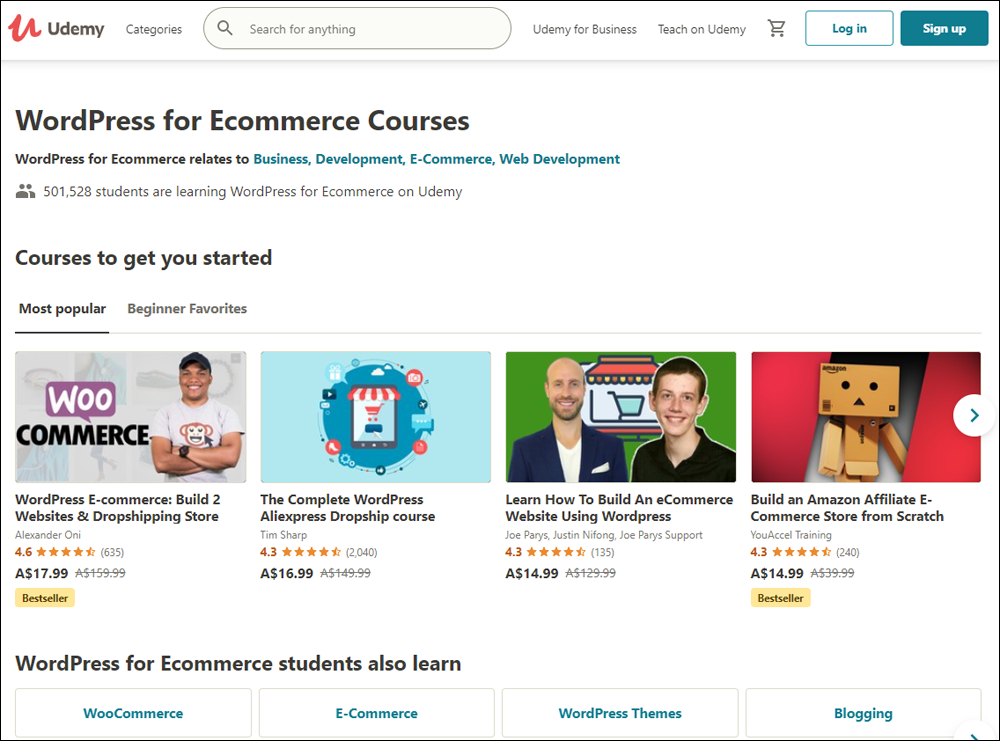
Publish Your eCourse On Your Own Website
You can also publish your e-course on your own website. While you may not get the exposure of an established eLearning platform, publishing on your own website is a great way to build an asset on your own domain name.
![]()
If you create an eBook and an eCourse, we recommend promoting your course inside your book. It will help you generate new leads and drive potential new students to your course.
Also, if you plan to add links to your course inside your book, consider driving visitors to your website, and not to an external URL.
Sending visitors to sites that you have no control over often leads to links pointing to dead destinations. You can still run your course on an online platform – just refer users to a page on your website promoting your course and add the course URL to your web page.
Alternatively, consider publishing links in your book using a link redirection tool.
A link management tool gives you complete control over the destination URLs of your links, so if anything happens, you can easily and automatically update all links and redirect your visitors somewhere else. This will also save you a great deal of time and headaches trying to locate where you have placed those links and then editing and republishing your book or course pages to fix broken links.
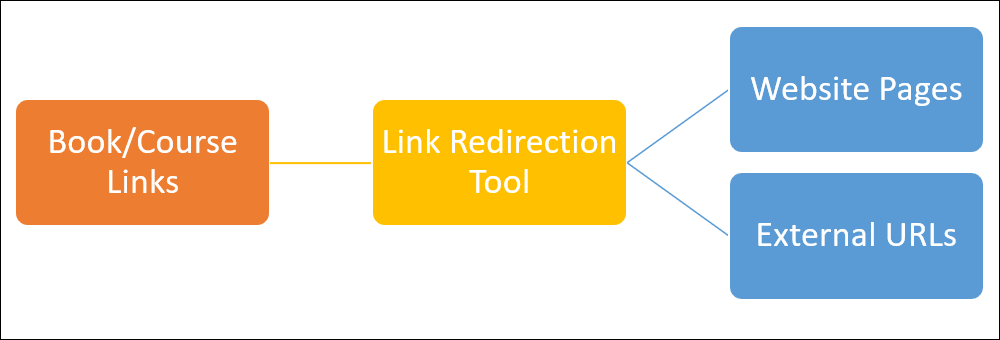
Publishing Your eCourse With WordPress
Let’s show you how to publish your course using a setup that lets you automate processes like online marketing, content marketing, payment and registration of new members, affiliate marketing, email marketing, etc. and that gives you complete control over all aspects of creating, delivering and promoting your course.
The platform that lets you do all this and more is WordPress.
WordPress not only can be used to set up a website or blog for your business, it also lets you easily set up and run e-learning courses that integrate seamlessly with your website, add payment and registration facilities, a private member’s area, an affiliate management system, and a whole lot more.
Best of all, WordPress is FREE, easy to use, affordable, and lets you do almost anything you can imagine.
To learn more about all the benefits and advantages of using WordPress, go here: 50+ Reasons To Choose WordPress
If you haven’t built a website yet, we recommend choosing WordPress.
If you have a website that wasn’t built using WordPress, we recommend adding a WordPress blog to drive more traffic and help you better market and promote your existing site.
An expertly-configured WordPress site or blog will automate processes like search engine indexing and content syndication to social media and other traffic-getting sites and online directories. This will help you get higher rankings in search engines and drive more traffic to your site whenever you publish new content.
Additionally, consider adding plugins to your site that will automate processes like:
- Creating and organizing your online course
- Accepting payments online
- Registering new course members
- Subscribing course members to your email list, and
- Giving them password-protected access to your course content
Let’s take a look at eCourse plugins you can install on your site to create and run online courses.
WP Courseware

WPCourseware lets you easily set up and configure training modules, course units, quizzes, include customized certificates of completion for course members, and more.
You can also specify how to deliver your course content (e.g. make all content available at once or only after previous modules have been completed, drip-feed content, etc.)
For more information about this plugin, go here: WPCourseware
LearnDash

LearnDash is an elearning plugin for WordPress used to power the learning programs of major universities, small to mid-size companies, startups, entrepreneurs, and bloggers worldwide.
The plugin’s features include a drag & drop course builder, advanced quizzing, dynamic content delivery with drip-feeding and module completion requirements, the ability to set access to courses, lessons, and quizzes based on members having attained specific prerequisites, and more.
For more information about this plugin, go here: LearnDash
Membership Plugins
If you want your course to be private so only paying customers can access it, then you will need to use a membership plugin.
A membership plugin automates the process of registering customers, delivering content to registered users, adding customers to email lists, etc.
There are many membership plugins available for WordPress users.
For more information on using membership plugins, download our comprehensive guide to creating membership sites with WordPress.
Accepting Payments Online
To accept payments online (e.g. PayPal), you will need a PayPal account and an eCommerce plugin.
You can just add a PayPal “buy now” button to your site, but then you will have to manually register all of your new course participants and give each user private access to your content (i.e. set up individual logins and passwords for every new member).
An eCommerce plugin can automate this process and send new members to your registration page after payment has been successfully processed.
There are many WordPress e-commerce plugins you can choose from. Platforms like WooCommerce are free but you have to purchase additional premium features as you need them (e.g. automated invoices, product enhancement features, etc.)
Certain WordPress themes have built-in payment processing features. Also. many merchant networks can integrate affiliate marketing, payment processing, and member registration all within your site.
To learn more about e-Commerce plugins and selling your course online, download our eCommerce Guide for WordPress users.
Promoting Your eBook & eCourse
It is beyond the scope of these tutorials to provide comprehensive information on marketing your business online.
Having said that, let’s discuss some effective ways to promote your book and online course:
Promote It On Your Website Or Blog
Make sure that your website has been expertly configured to maximize the effectiveness of your published content.
As mentioned earlier, an expertly-configured WordPress site can automate processes that will help your content get indexed quickly by search engines, increase exposure, visibility, and reach using content syndication, post excerpts, and links on all your social media channels, and more.
Once your site has been expertly configured, all you have to do is publish content and direct visitors to your book or online course in your call to action, sidebar area, inline banner ads, etc.
Every new post you publish is like hiring an enthusiastic salesperson who will work 24/7 to promote your business, so the more you publish, the more opportunities you will create to attract new customers for your ebook(s) and ecourse(s).
If you need help coming up with great content ideas, we recommend subscribing to our FREE Content Creation course here: Learn How To Never Run Out Of Content For Your Website, Blog, Or Newsletter
Here are some additional things you can do to promote your book and online course on your website or blog:
- Add promotional banners to your site (use a banner management plugin to automate this task),
- Promote your book and online course in your newsletter or email updates. Offer visitors a FREE sample chapter of your book or access to a sample video of your course as an incentive to sign up for your newsletter.
- Install an analytics plugin and use the data gathered from your site to improve your content marketing strategy, test online ads, create promotions, etc.
Press Releases
Announcing the launch of your new book or course on media outlets and news websites using a press release is a powerful and effective way to reach new users.
Learn how to create effective news releases or hire someone to do this for you and consider sending out monthly news releases for maximum impact.
Affiliate Programs
An affiliate is someone who gets paid a percentage of any sales they help to create through their recommendations and promotional efforts.
A good affiliate program lets users register and enroll themselves automatically and assigns them a unique affiliate ID and a special URL they can use in their email and website promotions to track their referrals.
When people click on an affiliate link, the software then identifies where the referral came from and if a sale is made, it works out how much commission to pay the affiliate and deposits the balance of the sale into your bank account.
Affiliate Management Platforms
You can run an affiliate program on your own website or use an affiliate network to promote and recruit affiliates for your program.
There are a number of plugins you can use to run an affiliate program on your website.
If you’re just starting out, however, we recommend using an established network like JVZoo or ClickBank to promote your ebook or online course.
Affiliate management platforms:
- Have thousands of members that can find and promote your product, and
- Process sales and payments on your behalf, saving you from having to manually administer and manage affiliates and payment of commissions.
Email Marketing Service
If you plan to add course members to an email marketing list, then you will need an email marketing service that integrates seamlessly with your WordPress site.
Many WordPress membership, e-commerce, and learning management system plugins will automatically add new customers, members, and students to your email marketing list.
You can also set up an email marketing service to run lead generation campaigns, opt-in forms for newsletters, etc.
Live Events, Workshops & Seminars
Everything we have described so far will allow you to set up and automate a system that will help you market and promote your book and/or online course cost-effectively.
If you plan to run live events like workshops and seminars (and further promote your books and courses), WordPress offers various event management plugins that let you create and manage events, add event listings to your website, and automatically process booking registrations and payments, assign tickets, etc.
Content Marketing With Self-Published Content – FAQs
Here are frequently asked questions about content marketing with online courses and self-published content:
What are the benefits of integrating online courses into my content marketing strategy?
Online courses can enhance your brand’s authority and expertise, providing deep, valuable content that engages and educates your audience. They can also be a source of revenue and lead generation by attracting subscribers who are interested in specialized knowledge.
How can I create an online course using WordPress?
Use WordPress LMS (Learning Management System) plugins to create and manage your courses. These tools allow you to build course structures, add lessons, manage enrolments, and even handle payments directly from your WordPress site.
What content should I include in my online courses?
Focus on content that addresses specific problems or needs within your niche. Include a mix of written lessons, videos, quizzes, and downloadable resources to cater to different learning styles and enhance the educational value of your course.
How do I market my online courses effectively?
Promote your courses through your existing marketing channels, such as your website, social media, email newsletters, and blogs. Consider offering a free mini-course or a module as a lead magnet to attract potential students.
What challenges might I face when creating and selling online courses?
Challenges include creating high-quality, engaging content that stands out, effectively marketing your courses in a saturated market, and managing the technological aspects of course delivery. Providing ongoing support and updates to course materials can also be demanding.
Can online courses improve my SEO?
Yes, by creating content-rich course pages, you can target long-tail keywords and generate more site content, which can improve your SEO. Additionally, hosting courses on your site can increase dwell time and reduce bounce rates, both of which are beneficial for SEO.
How do I ensure my online courses are accessible to all users?
Make sure your course content is accessible by following web accessibility guidelines. This includes providing text alternatives for visual and audio content, ensuring website navigation can be done via keyboard, and using clear, concise language.
What is self-publishing, and why might WordPress users consider it for content dissemination?
Self-publishing involves authors independently publishing their content without traditional publishing houses. WordPress users may opt for self-publishing to maintain full creative control, publish content quickly, and reach a global audience directly through their websites.
What are the advantages of self-publishing content for WordPress users?
Self-publishing empowers WordPress users to retain ownership of their content, earn higher royalties, and release content on their schedule without reliance on external publishers. Additionally, it allows for immediate updates and revisions to published content.
What are the potential drawbacks or challenges of self-publishing for WordPress users?
Challenges of self-publishing include shouldering all publishing responsibilities, such as editing, formatting, and marketing. WordPress users may also face difficulties in gaining visibility and credibility compared to traditionally published authors.
How does self-publishing via WordPress compare to other platforms like Medium?
Self-publishing on WordPress provides greater customization options, control over branding, and ownership of the content and platform. However, it requires more technical expertise for setup and maintenance compared to user-friendly platforms like Medium.
What tools and plugins can assist WordPress users in self-publishing content effectively?
WordPress users can leverage SEO plugins for optimizing content for search engines, Grammarly for proofreading, and membership plugins for selling digital content directly on their websites.
Summary
Publishing a book and creating an online course allow you to profit from your expertise and offer powerful ways to attract new clients and add new revenue streams to your business.
Best of all, this can all be done cost-effectively through self-publishing methods and inexpensive solutions.
We hope that you have found the above information on creating ebooks and online courses useful.

For additional tutorials on ways to create content for your website, go here: Content Marketing With WordPress
***
Updated: July 5th, 2024
